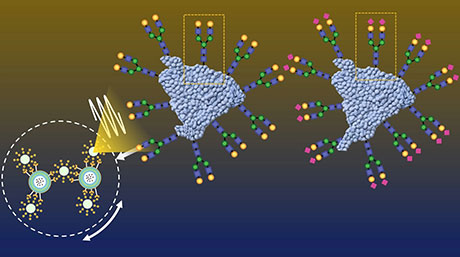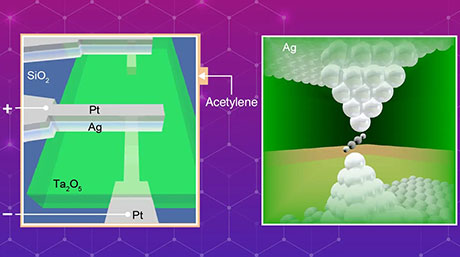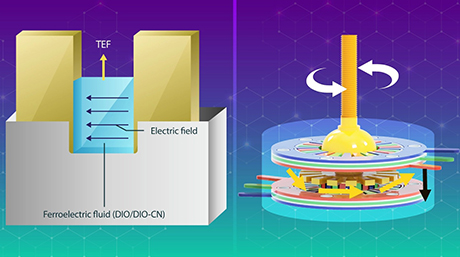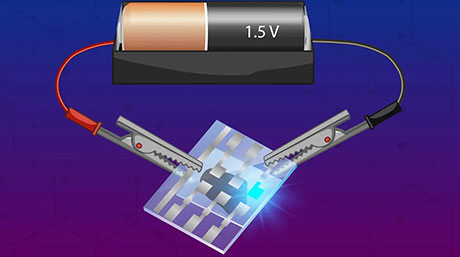Materials Science and Engineering News
An 'exceptionally stable' single-atom catalyst: Single platinum atoms stabilized in C12A7 crystals
Scientists at Tokyo Institute of Technology (Tokyo Tech) have shown that single platinum atoms trapped in C12A7 crystals act as a stable and effective catalyst for the hydrogenation of nitroarenes, an essential process in the production of many kinds of fine chemicals. Their approach could become a versatile route for developing other single-atom catalysts for wide-ranging industrial applications.

Figure 1. Single platinum atoms stabilized in C12A7 crystals
- Interaction between negatively charged ions and positively charged surface cavities of C12A7 for effective stabilization of single platinum atoms.
Single-atom catalysts (SACs) are on the way to becoming dream catalysts ― ones that exhibit superb performance based on optimized usage of metal atoms. Many research teams around the world have been working to advance the scalable development of SACs since they were first proposed by Tao Zhang and colleagues in China and the US in 2011.
Now, in a proof-of-concept study that throws the door wide open to developing a new range of SACs, researchers at Tokyo Tech have designed and tested a catalyst composed of single platinum atoms trapped in C12A7, a nanoporous crystal widely used in the production of aluminous cement.
The inner structure of C12A7 crystals is "just the right size" for trapping single metal atoms, the researchers say in their paper published in Nature Communications.
"Our approach is rather like a 'diamond-in-a-ring' strategy, where the surface cavity of C12A7 can be regarded as a ring, and the single platinum atom is fixed on the ring as a diamond," says first author Tian-Nan Ye at Tokyo Tech's Materials Research Center for Element Strategy.
Ye explains that C12A7 has a positively charged framework structure composed of twelve sub-nanometer-sized cages, each with an inner diameter of around 0.4 nanometers ― a suitable size for capturing individual metal atoms. Each cage has a positive charge of +1/3, and the surface cavities have an open 'mouth' that can trap single metal atoms through electronic interaction.
The catalyst has been demonstrated to be highly stable and active toward the selective hydrogenation of nitroarenes, an important process often used in the dye and polymer industries. It has a higher turnover frequency (up to 25772 per hour) than that of platinum-based catalysts unsupported by C12A7. Remarkably, the new catalyst even works at temperatures of up to 600°C.
Based on these promising results, the researchers investigated whether the trapping effect might work using other metals. As they predicted, C12A7 was also capable of capturing single atoms of ruthenium and rhodium, indicating that their strategy would be applicable to various transition metals.
"Our findings open countless doors to developing new kinds of SACs for different catalytic processes," says Ye. Due to its exceptionally high thermal stability, the C12A7 support would be able to withstand harsher conditions involved in other industrially important processes such as ammonia synthesis and CO2 reduction.
Ye points out that the development of SACs cannot be separated from the exploration of new materials. This is a key reason why Professor Hideo Hosono's group at Tokyo Tech is uniquely positioned to be a pioneer in SAC research, he says, building on a series of achievements including the development of novel semiconductors, an iron-based superconductor, and the first room-temperature-stable electride.
- Reference
| Authors : | Tian-Nan Ye1,6, Zewen Xiao2,6, Jiang Li1, Yutong Gong3, Hitoshi Abe4,5, Yasuhiro Niwa4, Masato Sasase1, Masaaki Kitano1 & Hideo Hosono1 |
|---|---|
| Title of original paper : | Stable single platinum atoms trapped in sub-nanometer cavities in 12CaO·7Al2O3 for chemoselective hydrogenation of nitroarenes. |
| Journal : | Nature Communications (2019) |
| DOI : | 10.1038/s41467-019-14216-9 |
| Affiliations : |
1 Materials Research Center for Element Strategy, Tokyo Institute of Technology 2 Wuhan National Laboratory for Optoelectronics, Huazhong University of Science and Technology 3 International Center for Materials Discovery, School of Materials Science and Engineering, Northwestern Polytechnical University 4 High Energy Accelerator Research Organization, KEK 5 Department of Materials Structure Science, School of High Energy Accelerator Science, SOKENDAI, The Graduate University for Advanced Studies 6 These authors contributed equally: Tian-Nan Ye, Zewen Xiao. |
- A nanoscale lattice of palladium and yttrium makes for a superlative carbon-linking catalyst | Tokyo Tech News
- Efficient bottom-up synthesis of new perovskite material for the production of ammonia | Tokyo Tech News
- Highly efficient ammonia synthesis catalyst developed | Tokyo Tech News
- Development of highly active and stable ammonia synthesis catalyst under low temperatures | Tokyo Tech News
- Drastic Improvement of Ammonia Production at Metal-Insulator Transition | Tokyo Tech News
- A new catalyst redefines rate limitations in ammonia production | Tokyo Tech News
- Hideo Hosono - Manipulating electrons well to elicit the potential of materials, Part 1 | Research Stories | Research
- Hideo Hosono - Manipulating electrons well to elicit the potential of materials, Part 2 | Research Stories | Research
- Professors Hideo Hosono and Yoshinori Ohsumi chosen as Thomson Reuters Citation Laureates | Research Stories | Research
- Hideo Hosono's story of IGZO TFT development features in Nature Electronics | Tokyo Tech News
- Professor Hideo Hosono elected as Foreign Member of Royal Society | Tokyo Tech News
- Researcher Profile | Tokyo Tech STAR Search - Jiang Li
- Researcher Profile | Tokyo Tech STAR Search - Hideo Hosono
- Materials Research Center for Element Strategy, Tokyo Institute of Technology
- Latest Research News
Further Information
Assistant Professor Tian-Nan Ye
Materials Research Center for Element Strategy, Tokyo Institute of Technology
Email ytn2015@mces.titech.ac.jp
Honorary Professor Hideo HosonoMaterials Research Center for Element Strategy, Tokyo Institute of Technology
Email hosono@mces.titech.ac.jp
Tel +81-45-924-5009





